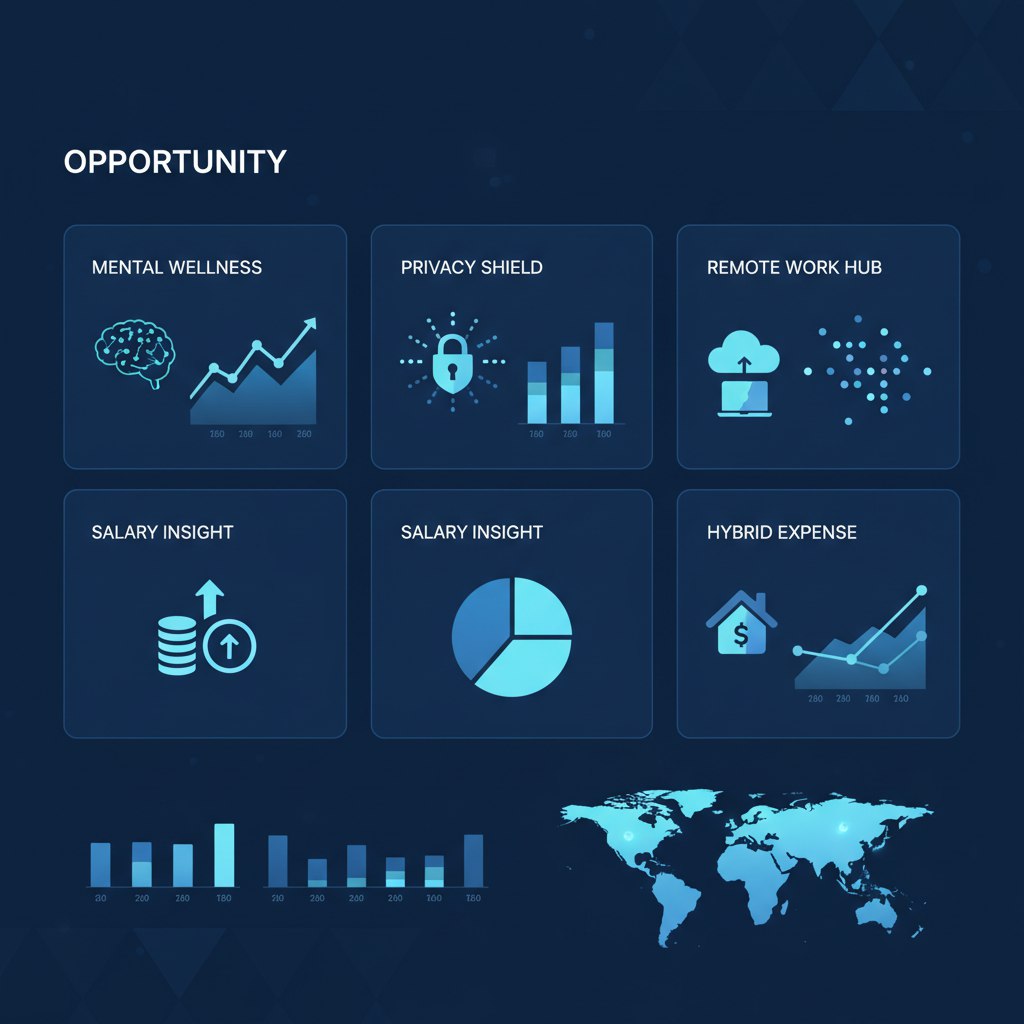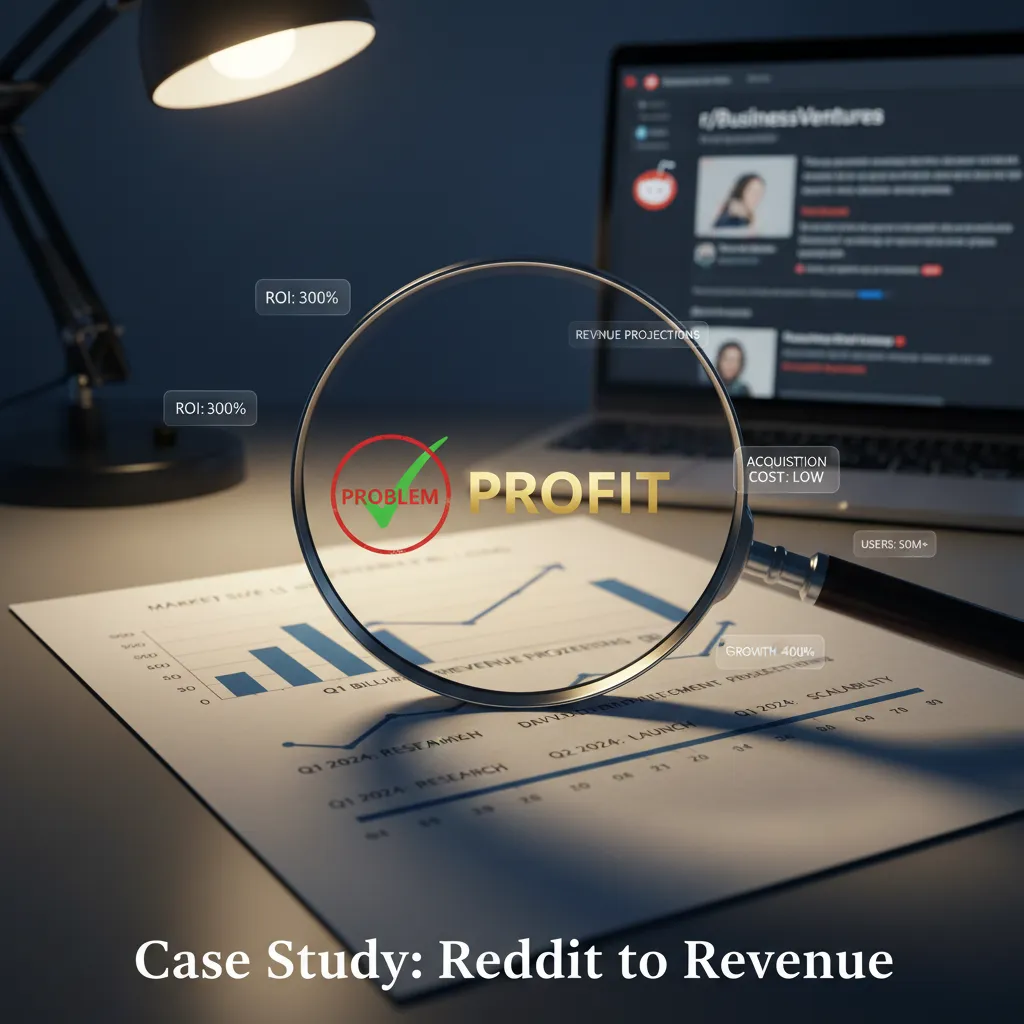8,261 upvotes. That’s not just Reddit engagement—it’s a signal that someone cracked a code the mental health industry has been fumbling for years.
The entrepreneurs hunting opportunities on Reddit aren’t chasing hype. They’re watching thousands of people organically gather around their pain points, upvoting solutions they desperately want to exist. This week’s analysis from IdeaHunter reveals five business ideas that captured meaningful traction across communities where people vent frustrations and dream about better tools.
Let’s examine what made these concepts resonate.
1. The Mental Health Play Hiding in Plain Sight: MindGarden
Market Reality: $45 billion TAM | 8,261 upvotes | Opportunity Score: 7.6
Most mental health apps target diagnosed conditions. MindGarden spotted the massive gap before the diagnosis—the creeping boredom and disconnection that precedes clinical anxiety and depression.
The Problem: “Combating boredom by promoting mental health and productivity through a unique approach” captures something psychiatry has struggled to monetize: the pre-clinical population who knows something’s off but won’t download a meditation app. These users scroll mindlessly, feel vaguely anxious, and wouldn’t be caught dead on BetterHelp.
The Solution: An “app that uses a gamified garden metaphor” turns mental health maintenance into something that doesn’t feel like therapy. You’re not fixing yourself; you’re growing a garden. The psychological sleight-of-hand matters enormously for user acquisition in this demographic.
Validation Breakdown: Those 8,261 upvotes represent the highest engagement in this analysis. The feasibility score sits at 6.8—not trivial, but achievable for a mobile-first team. Competitors like Headspace and Calm have proven the willingness to pay, but they’ve also revealed their blind spot: they’re too explicitly wellness-focused for the “I’m fine, just bored” crowd.
Why This Works: The gamification approach creates a daily habit loop without the emotional weight of admitting you need mental health support. That’s a wedge into a $45 billion market where user acquisition costs are brutal, but retention can be extraordinary once habit formation kicks in.
The Risk: Gamification is littered with corpses of apps that felt gimmicky after week two. The garden metaphor needs genuine depth and variability, or this becomes another deleted app by day fourteen.
2. Privacy Guardian: The $50B Surveillance Problem Nobody’s Solving
Original Upvotes: 3,178 | Feasibility Score: 7.2 | TAM: $50 billion
Here’s the uncomfortable truth: your phone’s flashlight app probably accessed your contacts last Tuesday.
This idea flips the typical privacy narrative. Instead of preventing data collection (largely impossible), it makes surveillance visible in real-time.
Core Problem: “Detecting when apps are accessing personal data without user knowledge” addresses the gap between what privacy policies claim and what apps actually do. Users suspect they’re being tracked. They’re right. They just can’t see it happening.
The Approach: “An app that monitors and alerts users about unauthorized data access by other applications” transforms abstract paranoia into concrete information. The notification hits differently when it says “Instagram accessed your microphone 14 times in the last hour” versus vague unease about being listened to.
The feasibility score of 7.2 suggests this is technically achievable, though platform restrictions (especially iOS sandboxing) present meaningful obstacles. Android offers more system-level access, pointing toward an Android-first launch strategy.
Market Positioning: The $50 billion TAM reflects the broader cybersecurity and privacy market. The realistic wedge is likely the 15-20% of smartphone users who are privacy-conscious enough to install something like this—still a massive addressable segment.
Competitive Landscape: Tools like Jumbo and DuckDuckGo offer privacy features, but they focus on web tracking and historical data cleanup. Real-time app surveillance monitoring remains relatively uncharted, particularly for non-technical users.
The Catch: Sustainable monetization in privacy tools is notoriously difficult. Users passionate about privacy often resist subscription models. Freemium with premium alerts and detailed analytics might work, but conversion rates will tell the real story.
3. Remote Work’s IP Tracking Nightmare: A $3.2B Opportunity in Digital Autonomy
TAM Estimate: $3.2 billion | Upvotes: 4,236 | Opportunity Score: 7.1
Remote workers discovered freedom, then discovered their employers could track every keystroke. This builds the escape hatch.
Problem Statement: “Protecting intellectual property and preventing tracking of remote workers’ personal projects” speaks to a specific horror story: the developer who builds a side project on their personal laptop, on their own time, only to have their employer claim ownership because they accessed it on company WiFi.
Solution Description: “An app that creates a secure workspace to prevent employers from tracking or claiming ownership of personal projects” essentially builds a digital DMZ between work life and personal creation.
With 4,236 upvotes, this resonates particularly in developer communities where IP ownership battles are both common and career-defining. The opportunity score of 7.1 reflects strong demand meeting reasonable technical complexity.
The Technical Challenge: Creating genuinely isolated environments that prevent tracking requires kernel-level operations or virtualization—not simple mobile app territory. This likely means desktop software with VPN integration, encrypted containers, and possibly blockchain-based timestamping to prove independent creation.
Companies like Boundary and various VPN providers touch adjacent space, but nothing specifically targets the “prove this side project is mine” use case.
Business Model Question: Is this B2C (workers protecting themselves) or B2B (progressive employers offering it as a benefit to attract talent)? The $3.2 billion TAM probably requires threading both needles. Workers won’t pay much monthly, but enterprises might pay per-seat for the recruiting advantage.
4. Hybrid Work Economics: Tracking the Invisible Costs
Upvotes: 3,631 | Feasibility Score: 8.0 | Market Potential: $3.2 billion
The feasibility score of 8.0 makes this the most buildable idea in our analysis. Sometimes the best opportunities aren’t the hardest.
The Insight: “Helping employees track and manage the costs associated with hybrid work arrangements” reveals an accounting gap. Companies track office costs obsessively. Employees subsidizing hybrid work with home internet, electricity, and space? Nobody’s quantifying that.
The Solution: “An app that calculates and optimizes hybrid work expenses for reimbursement or tax purposes” turns frustration into documentation. More importantly, it turns documentation into negotiation leverage.
This scored 3,631 upvotes because it solves a problem people actively complain about but haven’t seen tools address. The market includes every hybrid worker negotiating their arrangement—millions of people in the U.S. alone.
Competitive Assessment: Expense tracking apps like Expensify exist, but they’re general-purpose. The competitive advantage here is specificity: pre-loaded categories for home office depreciation, utilities formulas, commute cost calculators. Becoming the “TurboTax for hybrid work expenses” could build defensibility through domain expertise.
Revenue Path: Freemium for basic tracking, premium for tax optimization and employer negotiation templates. Potential B2B2C play where HR departments provide it to employees, though that faces long sales cycles.
Why the High Feasibility Works: Mobile app with straightforward data inputs, calculation formulas, and PDF export. No AI required. No complex integrations. Just useful math and good UX.
5. Salary Intelligence: Information Asymmetry as a Service
Original Upvotes: 3,252 | Opportunity Score: 7.3 | TAM: $3.2 billion
Employers know what everyone’s paid. Employees don’t. That’s a $3.2 billion information gap.
Problem Definition: “Providing salary insights and negotiation strategies for remote workers” attacks one of capitalism’s most profitable inefficiencies—pay secrecy.
The Execution: “An app offering real-time salary data and personalized negotiation advice based on market trends” combines Glassdoor’s data approach with ChatGPT-style personalization.
The 3,252 upvotes signal demand, but the challenge is data freshness. Platforms like Levels.fyi and Blind have traction here, which both validates the market and raises competitive concerns. The opportunity score of 7.3 suggests there’s room for differentiation—possibly geographic focus, role specificity, or superior negotiation coaching.
The Data Moat Question: Salary data becomes valuable at scale. Cold-start is brutal: why share your salary info when there’s no database to query? Solving this likely requires scraping public sources, partnerships with recruiters, or aggressive incentives for early data contributors.
Monetization: Subscription for job seekers preparing for negotiations, or commission-based where the app takes a percentage of salary increases it helps negotiate. The latter is compelling but requires proving causation.
The Pattern Behind the Upvotes
All five ideas share a structural advantage: they turn invisible problems into visible data.
MindGarden makes mental health visible as a garden. Privacy Guardian makes data surveillance visible as notifications. The IP tracking app makes ownership boundaries visible. Hybrid cost tracking makes subsidies visible. Salary intelligence makes pay gaps visible.
When you make the invisible visible, people can finally act on it. That’s worth an upvote—and potentially, a subscription.
Ready to discover more validated opportunities? Explore the complete analysis and scoring methodology at IdeaHunter.ai, where we track emerging business ideas across Reddit’s most active communities, scoring them on feasibility, market potential, and competitive dynamics.





